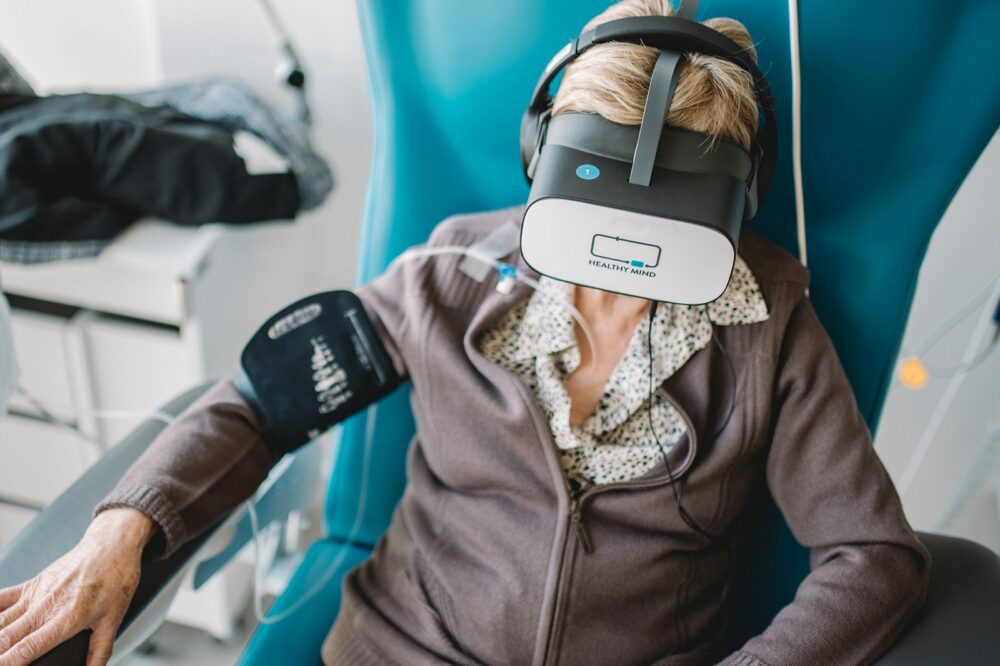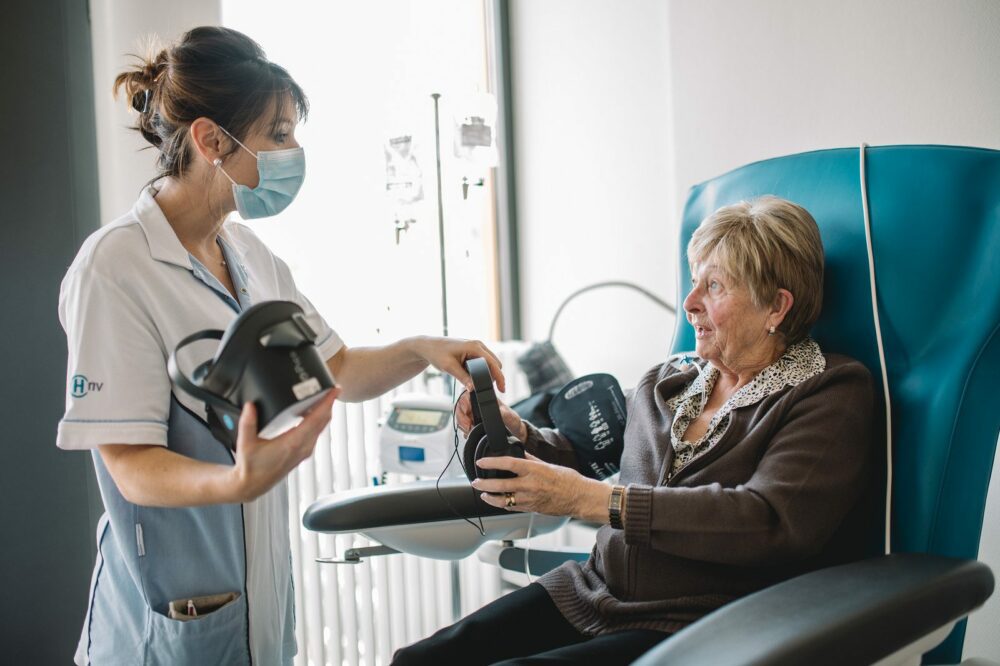The Mederic Alzheimer Foundation indicates that 57% of residents in EHPAD (accommodation establishments for dependent elderly people) suffer from moderate to severe cognitive disorders. Neurodegenerative disorders deprive seniors of their autonomy and their social life, a determining factor for their well-being. The management of physiological and psychological disorders in the elderly is a real public health issue, especially as the population ages. Virtual reality in nursing homes offers a flexible solution that can be easily integrated into care practices, in addition to adapting to patients and their pathologies. So what are the benefits of VR? We share 5 positive effects that will convince you to try the device.
1. Providing a unique multi-sensory experience in geriatrics
Usually when someone is brooding, bored or has just experienced an emotional shock, they are advised to take their mind off things, including encouraging them to get out of the house. Walking awakens the senses and invites the person to turn away from his or her ailments and focus on the environment. However, walking outdoors is not always accessible to all residents.
Virtual reality in nursing homes offers residents the opportunity to enjoy this multi-sensory experience by removing the physical constraints of moving around. The quality of the graphic environments, the breathing exercises and the immersive sound atmosphere contribute to deep relaxation. The virtual journeys take the residents out of the monotony of everyday life and help them to feel less confined.
Diversionary approaches have long been used in retirement homes to free the minds of anxious or apathetic people. This principle can be found, for example, in the Snoezelen space or the practice of sophrology. Virtual reality is based on the same process, but it is surprisingly effective for patients with advanced degrees of cognitive dependence.
2. Stimulating the cognitive functions of seniors with virtual reality in nursing homes
The simulations offered by the 3D glasses make it possible to create interactive exercises that stimulate the cognitive functions of residents, without fearing the risk of falling. The ambition of virtual reality does not necessarily lie in the creation of activities identical to daily life, such as the simulation of a card game or a ball toss. Rather, its interest lies in orientation and spatial memory. A systemic study of 22 research studies conducted in 2019 shows improvements in cognitive abilities such as memory or visual attention in individuals with mild disorders, stroke or Alzheimer’s disease.
The flexibility of the device easily adapts to the level of dependence of patients and is perfectly integrated into the practice of psychometricians, neuropsychologists, occupational therapists and the entire care team. The technological barrier does not hinder the appreciation of the experience since the playful aspect favours the appropriation of the equipment.
The study by Appel et al in 2020 showed that no patient experienced any side effects from using VR, such as dizziness, disorientation or interference with hearing aids. Of the participants, 76% wanted to repeat the experience.

3. Easing anxiety and combating depression with an innovative device
According to the Directorate for Research, Studies, Evaluation and Statistics (Drees), between 20% and 33% of residents in EHPAD suffer from depression. This finding is in addition to another pathology that is widespread in retirement homes: apathy. Characterised by a loss of motivation, social withdrawal and a strong lack of energy, this behavioural disorder particularly affects Alzheimer’s patients, nearly 60% according to the Alzheimer’s Foundation.
The study by Geraets et al focused on the use of virtual reality in people suffering from generalised social anxiety disorder. The experiment led to an improvement in the anxiety state and associated depressive symptoms. This success was due to the reminiscence, discovery and relaxation experiences provided by the device. Virtual reality in nursing homes conveys intense emotions that promote the well-being of residents.
Virtual reality is an effective reminiscence therapy to intervene on cognition and apathetic condition of the elderly as demonstrated by the study of Saredakis et al in 2020.
4. Creating a memorable immersion to improve the well-being of the elderly
Virtual reality in nursing homes stimulates emotional memory and revives buried souvenirs. The 360° vision of the device amplifies reminiscence and contributes to a deep sense of immersion. Returning to beloved places provides a sense of calm and offers residents a comforting link with themselves.
The 2015 study by Benoit et al indicates that VR stimulates autobiographical memory as evidenced by the increase in conscious recall of familiar scenes in front of unfamiliar landscapes. Furthermore, this experiment highlights that virtual reality therapy does not trigger symptoms of fatigue or other side effects.
Virtual travel also strengthens family ties as the device bridges generational gaps. This entertaining approach brings all ages together around a common activity and encourages sharing. Similarly, the use of the equipment reopens the dialogue with the care teams without the need for a heavy set-up. Residents are invited to talk about their experiences and describe their sensations, which encourages social interaction and interactivity.

5. Relieving pain with an analgesic effect
Therapeutic virtual reality has been developed to combat pain and anxiety. Hunter Hoffman and his team at the University of Washington were the first to establish an environment designed to make procedures less anxiety-provoking. To this end, the SnowWorld programme offered burn patients the chance to wander through an icy canyon alongside penguins and mammoths. This immersive experience was a great success as it reduced pain by 35-50% according to a 2011 study by Hoffman et al.
Since then, the equipment has become lighter and the techniques more sophisticated. For example, the 2016 study by Jones et al reported a 100% relative reduction in pain during immersion for participating chronic pain sufferers and total relief for 33%. The analgesic effects persist even after the experience, as the results show a reduction in pain perception of about 33% following exposure.
This formidable effectiveness has led to the widespread use of virtual reality in healthcare and the popularity of the VR device in the hospital. The Healthy Mind solution combines several principles to promote relaxation and limit analgesic medication. This is an incredible advantage in nursing homes to relieve residents’ pain while offering an effective non-drug alternative.
Residents of the Repotel EHPAD in Issy-les-Moulineaux have been using Healthy Mind virtual reality headsets since 2020. Baptiste Commagnac, director of the establishment, shares his impressions on the benefits of the device:
“We have observed beneficial effects in the residents concerned such as the calming of anxiety after the session, a feeling of satisfaction and a good impact on mood, positive expression and a desire to repeat the experience. These residents also see their cognitive functions stimulated (language and memory).”
Virtual reality in nursing homes reduces anxiety disorders, alleviates depressive symptoms, stimulates cognitive functions, revives memories and encourages communication with relatives and the care team. This innovative technology also has the advantage of being ergonomic and easy to set up. Would you like to try this device in your facility? We would be delighted to give you a demonstration.







